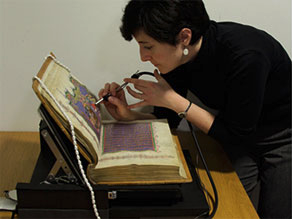Members Login

Channels
Special Offers & Promotions
Analytik Reports on the Exciting
Analytik, leading suppliers of innovative analytical instrumentation, report on the exciting “COLOUR: The Art and Science of Illuminated Manuscripts” exhibition at the Fitzwilliam Museum, University of Cambridge.
 Amongst various analytical instruments, the ASD FieldSpec 4 system was used to characterise both inorganic and organic materials (pigments and binders) on a number of illuminated manuscripts.
Amongst various analytical instruments, the ASD FieldSpec 4 system was used to characterise both inorganic and organic materials (pigments and binders) on a number of illuminated manuscripts.
The “COLOUR: The Art and Science of Illuminated Manuscripts” exhibition celebrates the Fitzwilliam’s 2016 bicentenary with a stunning display of 150 illuminated manuscripts from its rich collection. They range from the prayer-books of European royalty and merchants to local treasures like the Macclesfield Psalter, from an alchemical scroll and a duchess' wedding gift to the ABC of a five-year old princess.
The hundreds of images sheltered in volumes that were cherished in princely and religious libraries for centuries constitute the largest and best preserved repositories of medieval and Renaissance painting. With most panel and wall paintings destroyed by war, greed, puritanical zeal or time, illuminated manuscripts are the richest resources for the study of European painting between the sixth and the sixteenth century - the main focus of this exhibition. Highlights of Byzantine, Armenian, Persian and Sanskrit manuscripts are also included. Travel from eighth-century Northumbria to seventeenth-century Nepal via Oxford, Paris, Bruges, Cologne, Florence, Venice, Constantinople, Jerusalem and Kashmir.
Amongst various analytical instrumentation chosen to study these illuminated manuscripts and discover their secrets, the ASD FieldSpec 4 Vis-NIR spectroradiometer is highlighted here. The instrument was used to characterise both inorganic and organic materials (pigments and binders) on a number of illuminated manuscripts. The FieldSpec 4 has an extended operating range (350-2500 nm) and this is the key to the success of using this analytical equipment. It is the inclusion of the NIR region (1001-2500 nm) that allows for the analysis of some of the vibrational overtones and band combinations due to functional groups such as hydroxyls, carbonates, and potentially methylenic and amide groups associated with paint binders. For example, one can easily separate green malachite from mixtures of organic yellows and blue azurite. Both being copper carbonates, malachite and azurite are completely indistinguishable by X-ray fluorescence but the latter shows characteristic absorption bands at 1495, 2285, and 2350 nm.
Speaking of the FieldSpec 4 spectroradiometer, Dr Paola Ricciardi, a Research Scientist at the Fitzwilliam Museum, said that “the technical specifications including its high sensitivity and high spectral resolution make it the optimal tool to investigate thin and often complex paint layers. The rapidity of acquisition in addition to the instrument's compactness and portability allow surveying a large number of objects directly in exhibition Galleries or storage rooms. It may also yield a substantial comprehensive data set in a short period of time. This allows carrying out large-scale surveys, acquiring spectra on both test panels and works of art. The data then can be interpreted and used to both answer some of the art historical questions raised in the initial phase of the research and to inform subsequent phases of the analysis, during which the characterisation of the materials can be completed, when needed, using supplementary analytical methods such as Raman spectroscopy, XRF, and others.”
Speaking about the exhibition, Analytik's Product Specialist, Adrian Waltho, said “Seeing ancient manuscripts presented so beautifully was a real pleasure, and the science behind pigment identification with NIR spectroscopy is always fascinating. Having them together side by side was incredible and really brought the exhibition to life!”
Media Partners


